What a year has it been for Territory Studio and its founder David Sheldon-Hicks. It’s only been nine months since our interview about the studio’s screen graphics work on “Prometheus” and “Guardians of the Galaxy”, and in the meantime Territory’s work has graced the big screens on three major motion pictures! In this interview David talks about exploring the technical and human aspects of advances in the field of artificial intelligence in “Ex Machina“, the futuristic interfaces of the alien universe of “Jupiter Ascending” and the vast screen graphics canvas of “Avengers: Age of Ultron“. He touches on the collaboration with directors and production designers to distill and refine the visual language of the interfaces, the process of rapid prototyping in the pre-production phase and the tight back-and-forth adjustments of on-set playback sequences, and the technical aspects of projecting interface sequences on translucent glass screens. In the last part of the interview David takes a deep dive into the world of virtual reality interfaces, ranging from enhancing cinematic experiences to better leverage of content in our everyday work and leisure scenarios.
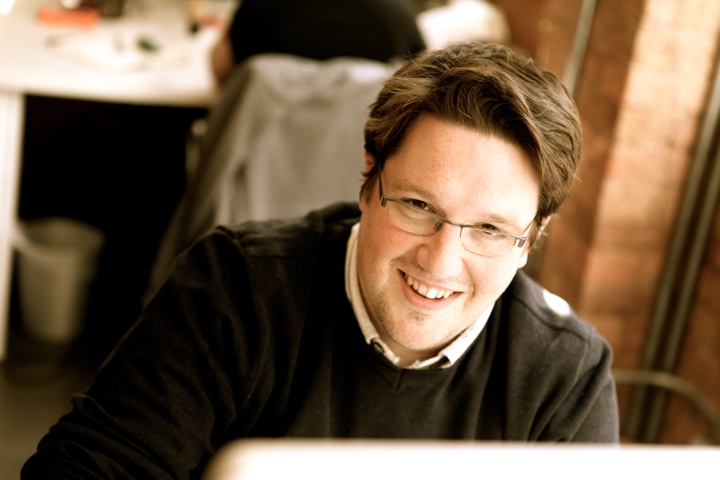
Kirill: Last time we spoke about your studio and its earlier work. And in the meantime you’ve had Jupiter Ascending, Ex Machina and Avengers: Age of Ultron come out, with a lot of work that you’ve contributed to these productions. And on top of that, you’ve started exploring the world of virtual reality.
David: We actually worked on Jupiter Ascending a year prior to that interview. The project took a while to come out (6 Feb 2015) so we haven’t been able to talk about it up until more recently.
Kirill: How does it feel that you have this pile of work that you’re sitting on and can’t tell anybody about?
David: In some ways it’s really frustrating, especially for the people in the studio who have worked on it. But, we’ve all signed NDAs, and don’t want to ruin it for the fans by saying something that might spoil the story.
Yet, it is quite nice to have a bit of time to prepare our portfolio and showcase, to fully do it justice in terms of the story behind all the work. When you’ve just finished a film, you’re so exhausted and still in that space. Sometimes it’s hard to look at the project objectively and fully appreciate all of the thinking and the ideas that went into it. When you have space and time – around six months or so ideally – you get enough distance to join up the dots between the deliberate and intuitive.
This gets really interesting when it comes to our approach to technology in a film like Avengers. By reflecting on how the script and story points influenced our research, we can sometimes see how quickly perceptions and expectations around innovations evolve.
Looking back we can see how public opinion regarded a piece of technology at the moment we were making the film, and how it changed over the 6 or 12 months leading up to it’s release – and hopefully we’re not behind technology!
Kirill: Does it worry you that the world of consumer technology is evolving so rapidly around us in that regard? Can your work quickly become outdated?
David: As a user, yes, because it’s hard to keep up sometimes. But as far as the work being outdated, in some ways we have to celebrate that. We play on the fact that it’s a film of the moment that reflects the cultural experiences of that point in time. It’s not just about the technology, but also about what the technology says about us as a culture. And I’ve always loved that about unashamedly 80s movies. For example, the idea of hoverboards in “Back to the Future” reflected our cultural expectations that skateboarding, so huge at the time, would exist in the future.
So the idea of a date stamp is not such a bad thing. If a film does date because of its views on technology, it can be quite enjoyable. And there’s an element of nostalgia in that, perhaps ten years into the future. You look back on it with fondness the same way you’ll look back at your current iPhone 5/6 when you’re holding your new iPhone 20 or whatever it might be.
Of course, there are other ways to explore technology and different films date in different ways.
In Ex Machina, Alex Garland [writer and director] was more interested in near-future thinking rather than techno-fantasy. He had done a lot of research around AI for the film to keep the story grounded, and we also undertook a lot of research into UI and UX in terms of where the technology is going. So our work in that film reflects the evolution of user experience towards simplicity, personalisation and ease of access, while it also reflects the narrative layers in the story.
Embedded just underneath the lovely uncluttered UI is access to programming code: we wanted it to feel that Nathan had created this OS for the benefit of the public, yet always kept close to the code, and could easily access and manipulate it.
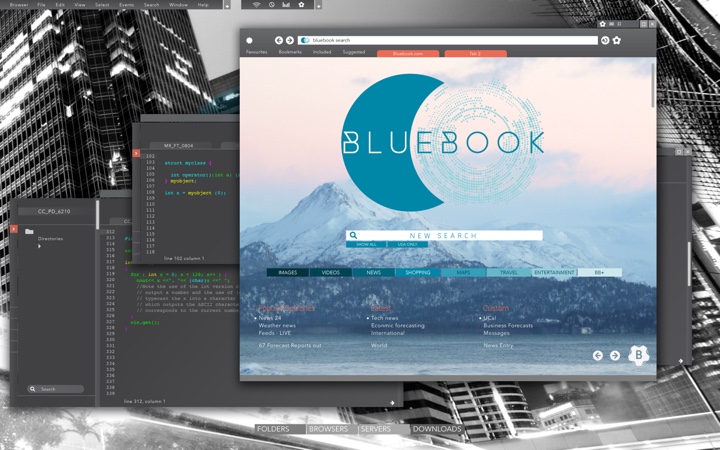
BlueBook office browser software in Ex Machina. Courtesy of Territory Studio.
So, while the work that we delivered made a loose statement on where UI and UX are going, it was also a technological window into narratives playing out around the film – a narrative device for the characters to monitor the activities around the building, for example.
I’m sure Ex Machina will date in a slightly different way other films of that genre because its focus is not to comment on future technology and it’s not tying itself into the cultural zeitgeist in terms of style. As a film about the thinking around AI and our relationship to technology at this time, it’s less a statement about aesthetics and more of a timeless piece.
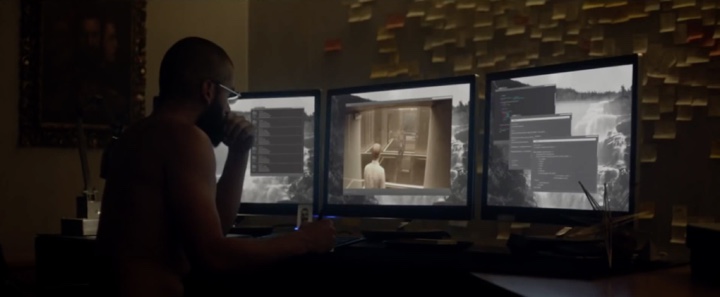
Ex Machina screens still. Courtesy of Territory Studio.
Continue reading »
At the intersection of art and technology, the ever-increasing importance of screen graphics in feature film reflects the expanding arc of human-computer interaction in our everyday lives and the pervasive presence of glass screens around us. It gives me great pleasure to welcome Andrew Booth of BLIND LTD to the ongoing series of interviews with designers and artists that bring user interfaces and graphics to the big screens. In the last few years you’ve seen their work on the “The Dark Knight” trilogy, “Hellboy”, “Skyfall”, “Jack Ryan” and the recently released “Kingsman: The Secret Service”, as well as in the cinematic trailers for the CRYSIS game franchise. In this interview Andrew talks about what drew him into the industry, the overall collaboration process within the feature production environment, approaching the technology world of Bond and Batman franchises to define the look and feel of the interfaces, constructing the visual language of the two competing factions in “Kingsman”, the primary goal of supporting the story and the effect it has on all aspects of the craft of screen graphics, and the two-way flow of ideas between the worlds of “fantasy” and “real” screens.
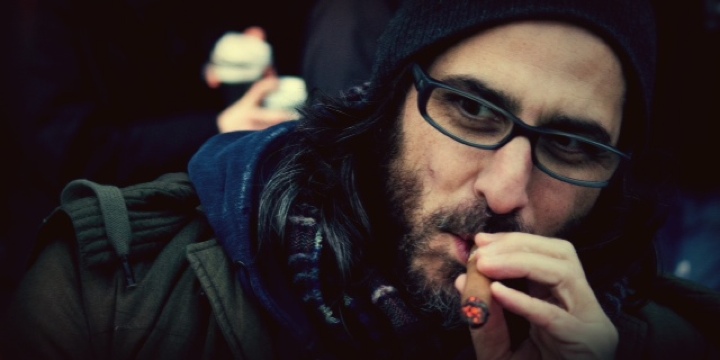
Kirill: Please tell us about yourself and how you got into the field of screen graphics for film.
Andrew: I love film and I love design, and it seemed a natural fit. I come from art and design background, and I like making things. It was good expressive way of doing something that was innovative and thought provoking.
Kirill: It would be a rather boring movie if all the technology it showed you would already be present in your life.
Andrew: I figure with screen graphics you want to see something that has a bit of escapism, excitement and drama about it.
Kirill: Does that get pushed by the director, the production designer and by yourself?
Andrew: Generally it’s all about the story, and within that you will have the graphical element that’s written on the page. Part of your work is reading the script, getting some ideas and then developing them.
As far as who we collaborate with? Generally speaking I deal directly with the director. We also work in conjunction and in collaboration with the art department and the visual effects supervisor.
One of the things that we do at BLIND, which is quite different from other agencies, is that we deal with graphics on set and in post.
The first film I ever worked on was “Die Another Day”. I wanted to get into films and ended up almost breaking into Pinewood Studios to visit the VFX supervisor at the time. I showed the work that I produced including a number of film specific test shots. I think the VFX supervisor was surprised that I got through the gates. Two weeks later I got a phone call and told that they had some post graphics work for me to do. That was my “in” to the industry.
Post is a very different animal compared to on set. You’re working to a specific cut length, and you might only have 12 frames to tell your story graphically.
My second job was for Guillermo Del Toro’s “Hellboy” where everything was live and on set. We had to be very diligent in the way we told the story.
Back to your question, at BLIND we collaborate with the production designer, the VFX supervisor and the director.
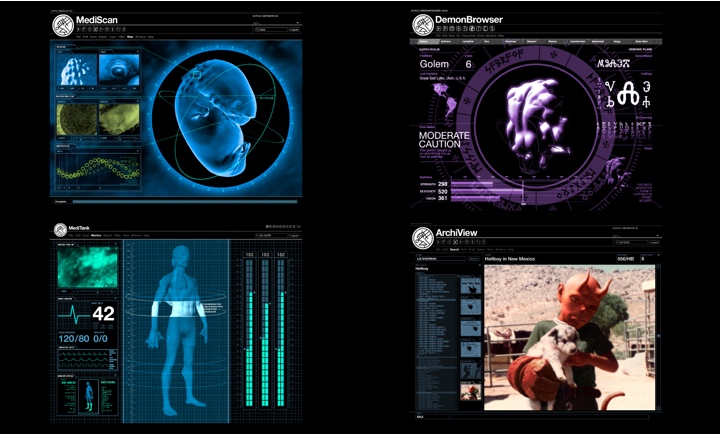
UI Screen graphics from Hellboy / http://www.blindltd.com/hellboy / Courtesy of BLIND LTD
Kirill: And that’s where the decision between doing things on set or in post production is made? Some directors would want to see more stuff directly in camera.
Andrew: It is cyclical.
On “Hellboy” “Sahara” “Batman Begins” “Doom” “Casino Royale” “The Dark Knight” our work had predominantly been on set. Then there was a step change where everyone moved away from doing it practically. I wondered if this part of the industry was dying away. Obviously it is easy to green everything up and then think about it afterwards, however with “The Dark Knight Rises” and “Skyfall” there was a return to the practicality of doing as much as you possibly can on set.
As we speak we’re doing an on set project with the VFX supervisor who got us involved in the post-production screen graphics for “Jack Ryan: Shadow Recruit”. We both know that we’re going to do things in post, but we’re trying to achieve as much as possible live.
It’s an interesting hybrid in terms of where we sit.
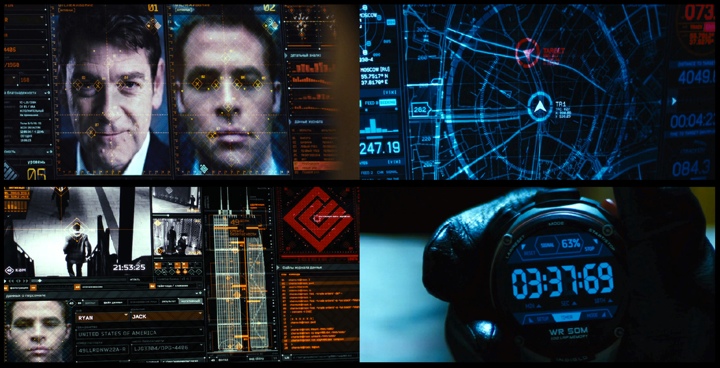
UI Screen graphics from Jack Ryan: Shadow Recruit / http://www.blindltd.com/jack-ryan / Courtesy of BLIND LTD
Continue reading »
Continuing the series of interviews with designers and artists that bring user interfaces and graphics to the big screens, today’s I’m excited to welcome Corey Bramall. His work spans multiple films and TV shows, from Caprica and Human Target on the small screen to Thor, Captain America: The Winter Soldier, Safe House, the first two G.I. Joe and the last three Transformers movies on the big screen – just to name a few. In this interview Corey talks about the changes his field has undergone in the last 15 years, differences between TV and feature productions, working on multiple movies in the Marvel and the Transformers franchises and striking the balance between the technical nature of real-world computers and making appealing visuals for the aesthetic purposes of the overall production.
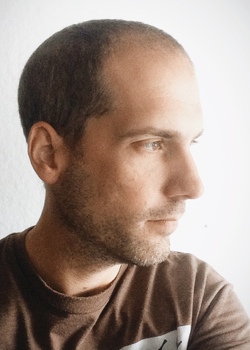 Kirill: Please tell us about yourself and what you do.
Kirill: Please tell us about yourself and what you do.
Corey: My name is Corey Bramall, I design and animate the graphics that are on computer screens in movies and tv shows known now as FUI (fictional or fantasy user interfaces). I have been doing this kind of work for around 15 years. I try to balance my life between family, work and play. When I’m not working I’m usually hanging out with my family or going to see live music.
Kirill: What drew you into the field of screen graphics, and how has that changed in the last 15 years or so of doing it?
Corey: I always had an interest in graphics, photography and computers so in high school I got on the yearbook design committee and was playing around with Photoshop 3… “now with layers!” and I remember thinking to myself “this is something.. I’m not sure what, but it’s something”. After high school I was working odd jobs and trying to figure out what I was going to do with my life but I could never shake how fun and creative this program called Photoshop was so eventually I found a two year multimedia program here in Vancouver that offered a variety of classes like ‘Interactive Authoring’, ‘Video Production’, ‘3D Animation’ and… ‘Photoshop’. After graduating the two year program in 1999 I was trained to make CD-Rom titles which of course had gone completely obsolete. I had no industry but I had this odd array of skills that made me sort of a ‘jack of all trades’.
I had found a job at a company that produced terrible course ware for educational training and was about to call it a career at 21 when I got a call from a studio asking if I was available immediately to come and work with them to make graphics for a tv show. I took the job and the rest is sort of history. I worked at that studio for a few years and eventually started Decca Digital. One of the biggest changes in the last 15 years I would say is what’s capable technically. When I started everything was 640×480 pixels and I could backup an entire months work on a single CD. Today most of the stuff I design is full HD (1920×1080 pixels) and can be almost 2GB for just one screen. The other biggest change is just the sheer number of people designing FUI screens.
Kirill: Who do you work for during the various stages of a production, from the initial explorations during the pre-productions all the way to the post-production?
Corey: A lot of my work happens during production where I’ll create graphics to be shot in a scene so they actually have to function in a rudimentary way. I’ll build them so the onset operators can turn widows on and off, move the widows around, change backgrounds and so on. This is an interesting process because as you’re designing you have to think about how the screen will function as well. It can provide some interesting design limitations that I have to overcome and sometimes re-think. Because replacing what’s on a screen in post-production has become much easier, quicker and cheaper, a lot of times directors want graphics on the screen that they know will be replaced later just so the actor has something to interact with instead of a giant green square. I’ve work on projects were I’ve just done the production graphics, just done post-production graphics for burn-in and I’ve done both.
Kirill: Do you prefer having a full artistic freedom for a project, or a more well-defined direction?
Corey: I don’t think I’ve ever had full artistic freedom on any project, that would be amazing to have that freedom one day. Given a choice, I’d obviously prefer full artistic freedom but a lot of my work in the last few years has been for sequels or for films that take place in a universe that was created prior to me being involved so my challenge has been to stay true to that while perhaps adding some of my own style. I tend to work with a lot of the same people who have a style that they’re accustomed to so I’m often bound to that aesthetic but I’ll always find somewhere to add some personal flare.
Kirill: What are your thoughts on the term “Fantasy UIs”? How well does it capture the essence of what you do?
Corey: I think it’s a good term for this type of work. Before Mark Coleran coined the term FUI we called it all sorts of things: computer playback, screen graphics, screen design and so on. But is it Fictional User Interfaces, Fantasy User Interfaces, Faux User Interfaces? Let’s just say it’s Fantasy, once and for all ok?

Continue reading »
Continuing the series of interviews with designers and artists that bring user interfaces and graphics to the big screens, it’s an honor to welcome David Sheldon-Hicks of Territory Studio. Prior to founding the studio in 2010 David has worked on “Casino Royale” and “Dark Knight”. Since then, Territory’s work can be seen in movies as diverse as “Zero Dark Thirty”, “Jack Ryan: Shadow Recruit”, “Prometheus”, “Guardians of the Galaxy” and the upcoming “Jupiter Ascending”. In this interview he talks about collaborating with the director, the art department and the VFX department throughout the different stages of a production, staying true to the look of the specific production such as aerial tracking in Zero Dark Thirty or high-tech science of Prometheus, the approach he’s taking to design futuristic interfaces, the physicality of technology around us and how it projects into his latest work on Guardians of the Galaxy, and the diverse gamut of projects Territory is working on and how they feed into each other.

From left to right: Peter Eszenyi, Nick Hill, Marti Romances and Ryan Rafferty-Phelan of Territory Studio at work on Guardians of the Galaxy.
Kirill: Please tell us about yourself and what you do.
David: I set up Territory in 2010 together with Lee Fasciani and Nick Glover. Having met while on a project, we wanted to work together and Territory seemed like a good name to describe our ambitions to carve our own path in the competitive creative sector here in London.
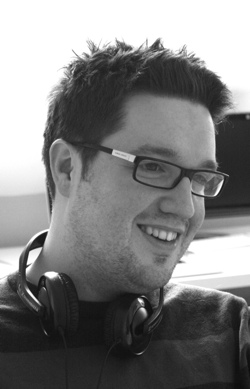 I’m Creative Director of Motion, with a background in graphic design, moving image and motion graphics – cutting my teeth in music videos before moving onto films, computer games and TV commercials.
I’m Creative Director of Motion, with a background in graphic design, moving image and motion graphics – cutting my teeth in music videos before moving onto films, computer games and TV commercials.
The studio combines a number of disciplines under one roof – motion graphics, animation and live action production, branding and UI across print and digital (web, mobile, tablet) and with the recent addition of Luke Miles as Director of Brand Experience, we are able to help brands engage audiences more affectively through physical and non-physical (service) design.
While that sounds like a strange mix, what ties it all together is our shared creative focus on human interaction, and future and near future challenges.
Film and gaming is really my heartland. Our first computer game project was for EA on “Medal of Honor”, which was one of the newer titles in 2010. They were going for a more “Modern Warfare” type of a game, and wanted an opening cinematic to tell the background story of why you [the player] were going to war.
Our first feature film project was “Prometheus” – a historic moment for Territory. Out of the blue we got a phone call from someone who wouldn’t tell us what the project was but it sounded interesting enough so we signed a couple of NDA’s. Then we were told that we’d be working on computer screen graphics for a new Ridley Scott film that was going to be a prequel to the Alien universe – at which point we freaked out. I’m a personal fan of Ridley Scott, and Ron Cobb’s universal language and iconography for the original Alien movie is held in very high regard in the design community. So to have the opportunity to explore that at an early stage was really exciting. The project itself has defined Territory’s approach to on-set screen graphics.
Kirill: And before Prometheus you worked on a couple more movie productions.
David: Yes, as a freelancer I worked on “Casino Royale” and “Dark Knight”. Both those projects were amazing and I loved the challenge and excitement of communicating complex concepts in a brief moment of pure user interface design that is also an intrinsic part of a sound stage environment that the actors engage with!
As Territory has grown, our user interface work for films has grown and developed as well, and we approach it as a discipline in its own right. We get different unique briefs and each one is a creative challenge. The beauty is in the idea of considering user experiences and interactions without the constraints of how you might build it. Sometimes it’s high tech, sci-fi future-thinking user interface, narrative thinking in computer games, or exploring future applications for tech giants such as Sony, Samsung or Microsoft.
We now find that the conceptual approach that we bring to film work appeals to other clients.
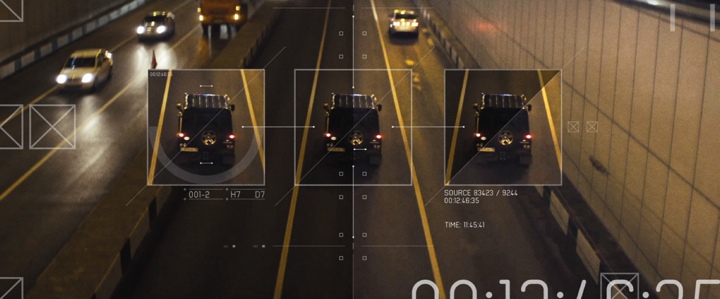
Tracking overlays for Jack Ryan: Shadow Recruit. Courtesy of Territory Studio.
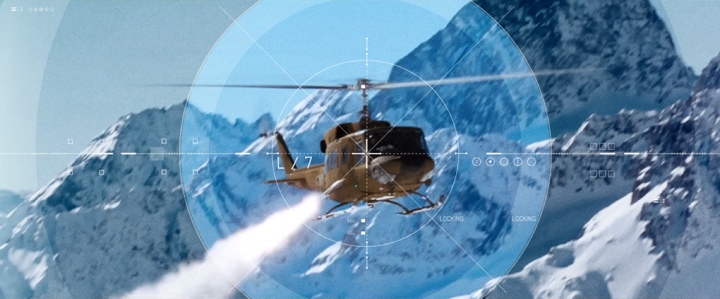
Tracking overlays for Jack Ryan: Shadow Recruit. Courtesy of Territory Studio.
Kirill: What about Zero Dark Thirty and Jack Ryan? Was it just you, or was it done by the Studio?
David: That was completed by Territory, rather than by me as an individual. We did “Zero Dark Thirty” after Prometheus, and it was at the opposite extreme in terms of sci-fi versus real-world narrative. It had to be very real and very authentic. There were a couple of visual effect shots but most of the computer screen graphics were on-set playbacks. The large screens where they’re looking at the Predator drone footage and reviewing aerial photography were all CGI plates that we had built and rendered in Cinema 4D, referencing data from Google Maps and then projecting on-set live for the actors to perform against.
We worked on two aspects of “Jack Ryan”; we created a lot of on-set graphics, and we also created what is called an ‘original content’ trailer. We took footage from the theatrical release trailer and did something unique with it – using hard overlays and surveillance technologies to suggest a narrative and suggesting background for some of the characters. In effect, we were using our UI graphical language both to set-dress the film and to advertise it.
Kirill: And for this type of movie your main constraint is that it’s very much rooted in the current technological world.
David: Definitely. Case in point, on Zero Dark Thirty I believe we had CIA signing-off on how realistic our work was, and what we could say to be true. For instance, we looked on Google Maps to see what the compound where Osama Bin Laden was hiding in looked like, and they asked us to change it to a degree so that it wasn’t exactly the same. There was online photography of the helicopter that crashed, and we approximated it as a 3D model and, again, changed it a bit for fictional purposes. It was an interesting, if delicate, balance to strike. And of course we had a typical sign-off from the art department – normal sources other than the CIA!

Control center from Zero Dark Thirty. Courtesy of Territory Studio.

Aerial footage from Zero Dark Thirty. Courtesy of Territory Studio.
Continue reading »
![]()
![]()
![]()